Political Science Essay: NDP and the Organized Labor Workforce
VerifiedAdded on 2023/01/11
|11
|2372
|76
Essay
AI Summary
This essay examines the complex relationship between the New Democratic Party (NDP) and organized labor in Canada. It begins by outlining the historical context of trade unionism and the NDP's strategies for supporting the workforce. The essay explores the NDP's ideals, ethical considerations, and shortcomings, including fundraising challenges and struggles to connect with the broader Canadian population. It discusses the views of labor leaders, the party's electoral performance, and its influence in various provinces. The analysis covers the evolution of the NDP, from its roots in the Co-operative Commonwealth Federation (CCF) to its successes and setbacks in federal elections. The essay concludes by assessing the NDP's impact on organized labor, highlighting the party's role in advocating for workers' rights and economic growth, while also acknowledging the challenges it has faced in maintaining its support base and relevance in Canadian politics. The essay uses various sources to support its arguments, providing a comprehensive overview of the NDP's interactions with organized labor.
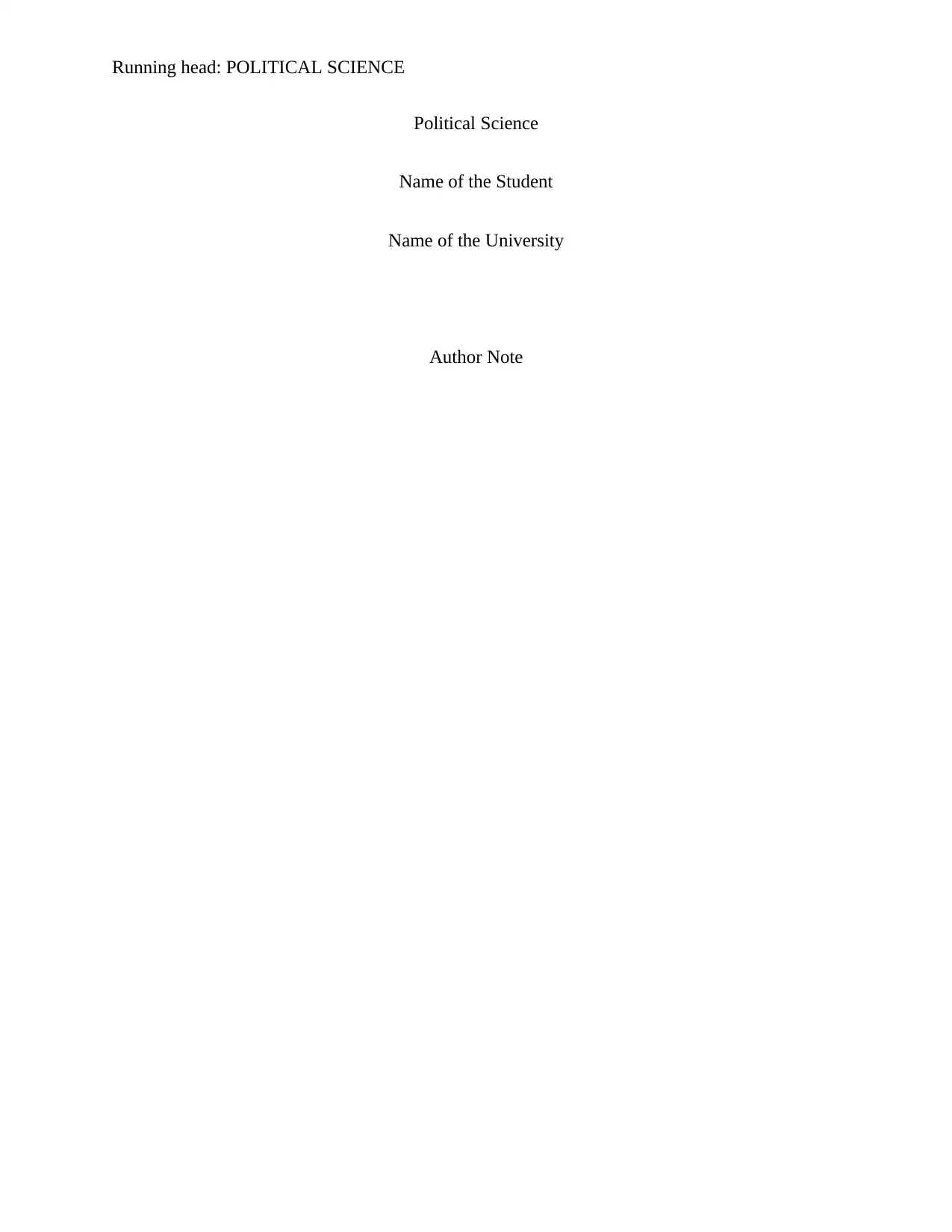
Running head: POLITICAL SCIENCE
Political Science
Name of the Student
Name of the University
Author Note
Political Science
Name of the Student
Name of the University
Author Note
Paraphrase This Document
Need a fresh take? Get an instant paraphrase of this document with our AI Paraphraser
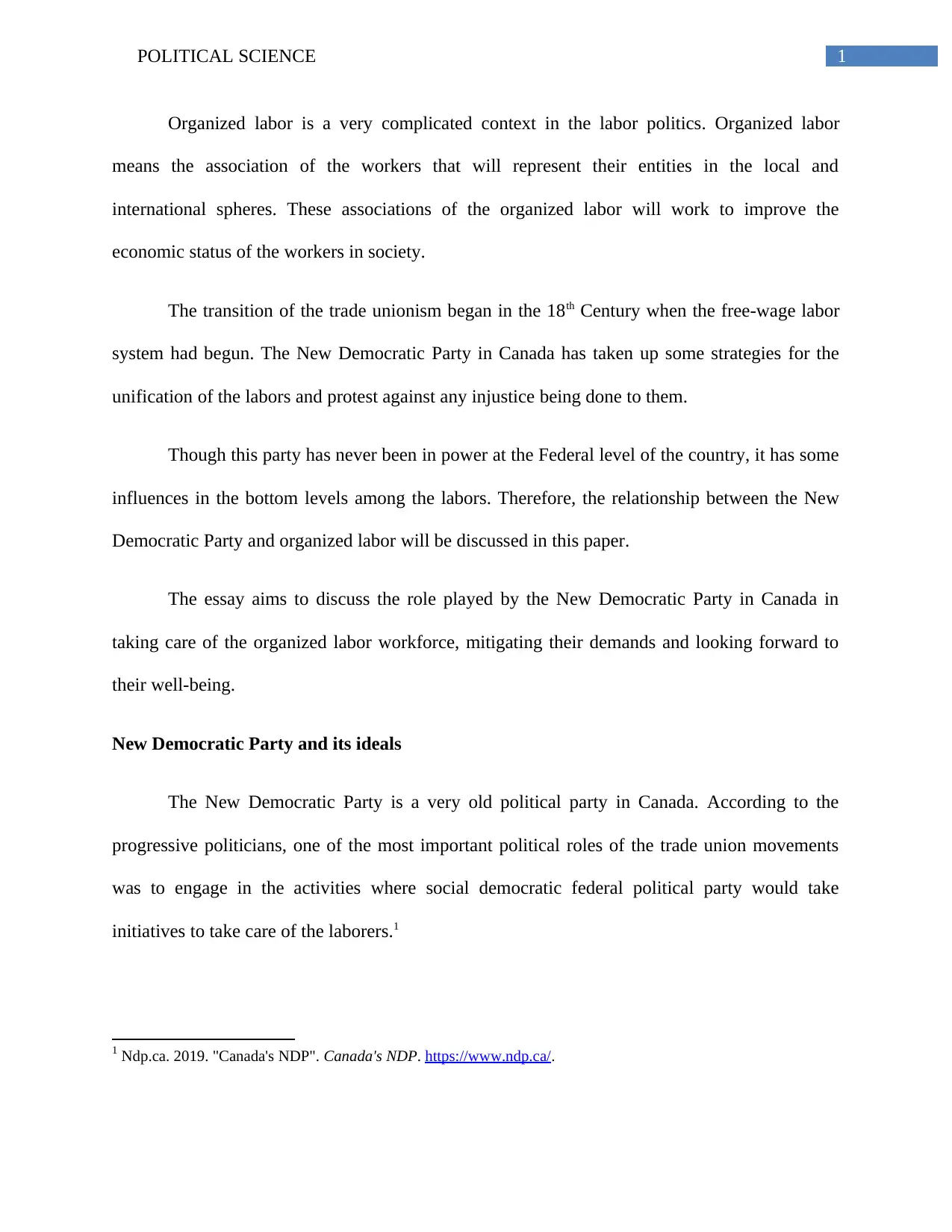
1POLITICAL SCIENCE
Organized labor is a very complicated context in the labor politics. Organized labor
means the association of the workers that will represent their entities in the local and
international spheres. These associations of the organized labor will work to improve the
economic status of the workers in society.
The transition of the trade unionism began in the 18th Century when the free-wage labor
system had begun. The New Democratic Party in Canada has taken up some strategies for the
unification of the labors and protest against any injustice being done to them.
Though this party has never been in power at the Federal level of the country, it has some
influences in the bottom levels among the labors. Therefore, the relationship between the New
Democratic Party and organized labor will be discussed in this paper.
The essay aims to discuss the role played by the New Democratic Party in Canada in
taking care of the organized labor workforce, mitigating their demands and looking forward to
their well-being.
New Democratic Party and its ideals
The New Democratic Party is a very old political party in Canada. According to the
progressive politicians, one of the most important political roles of the trade union movements
was to engage in the activities where social democratic federal political party would take
initiatives to take care of the laborers.1
1 Ndp.ca. 2019. "Canada's NDP". Canada's NDP. https://www.ndp.ca/.
Organized labor is a very complicated context in the labor politics. Organized labor
means the association of the workers that will represent their entities in the local and
international spheres. These associations of the organized labor will work to improve the
economic status of the workers in society.
The transition of the trade unionism began in the 18th Century when the free-wage labor
system had begun. The New Democratic Party in Canada has taken up some strategies for the
unification of the labors and protest against any injustice being done to them.
Though this party has never been in power at the Federal level of the country, it has some
influences in the bottom levels among the labors. Therefore, the relationship between the New
Democratic Party and organized labor will be discussed in this paper.
The essay aims to discuss the role played by the New Democratic Party in Canada in
taking care of the organized labor workforce, mitigating their demands and looking forward to
their well-being.
New Democratic Party and its ideals
The New Democratic Party is a very old political party in Canada. According to the
progressive politicians, one of the most important political roles of the trade union movements
was to engage in the activities where social democratic federal political party would take
initiatives to take care of the laborers.1
1 Ndp.ca. 2019. "Canada's NDP". Canada's NDP. https://www.ndp.ca/.
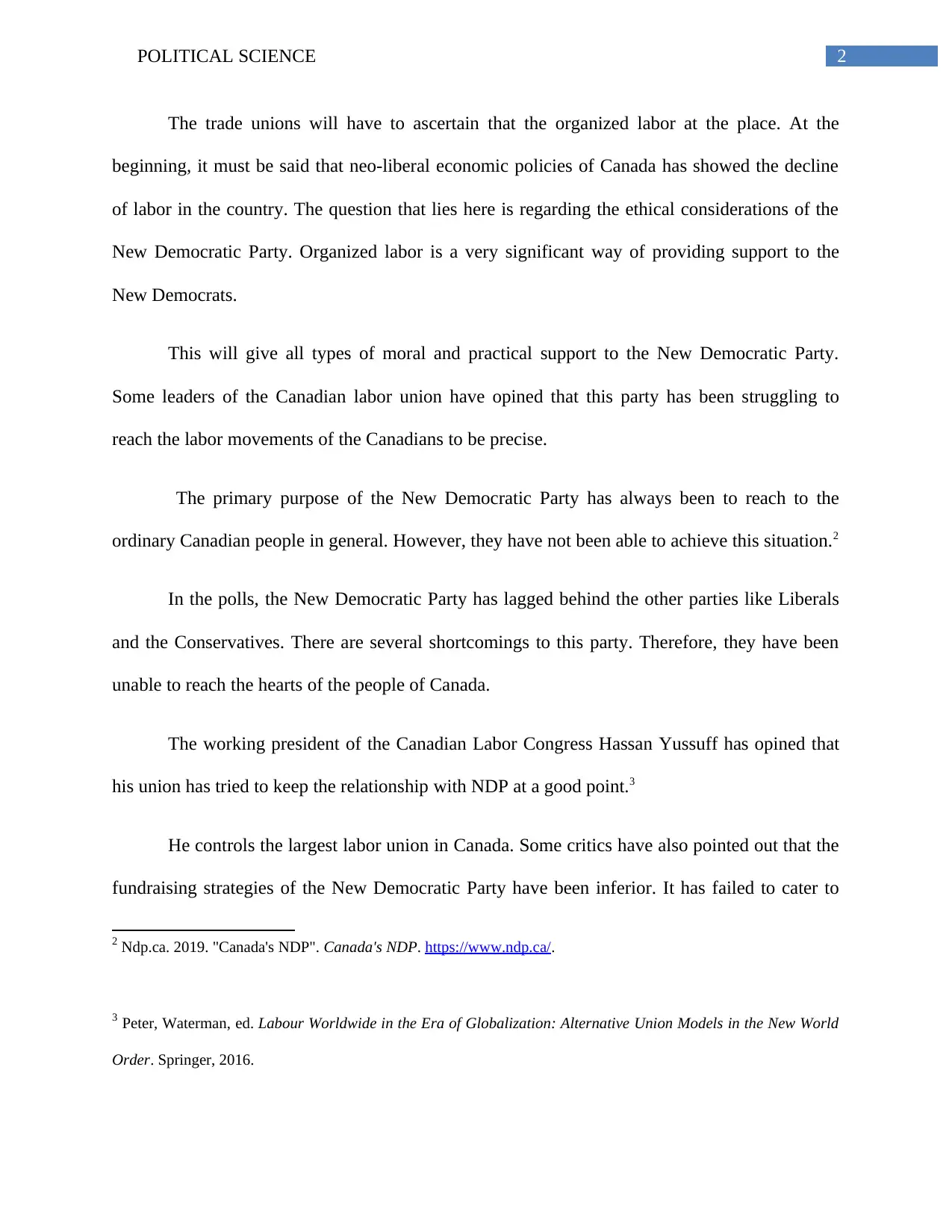
2POLITICAL SCIENCE
The trade unions will have to ascertain that the organized labor at the place. At the
beginning, it must be said that neo-liberal economic policies of Canada has showed the decline
of labor in the country. The question that lies here is regarding the ethical considerations of the
New Democratic Party. Organized labor is a very significant way of providing support to the
New Democrats.
This will give all types of moral and practical support to the New Democratic Party.
Some leaders of the Canadian labor union have opined that this party has been struggling to
reach the labor movements of the Canadians to be precise.
The primary purpose of the New Democratic Party has always been to reach to the
ordinary Canadian people in general. However, they have not been able to achieve this situation.2
In the polls, the New Democratic Party has lagged behind the other parties like Liberals
and the Conservatives. There are several shortcomings to this party. Therefore, they have been
unable to reach the hearts of the people of Canada.
The working president of the Canadian Labor Congress Hassan Yussuff has opined that
his union has tried to keep the relationship with NDP at a good point.3
He controls the largest labor union in Canada. Some critics have also pointed out that the
fundraising strategies of the New Democratic Party have been inferior. It has failed to cater to
2 Ndp.ca. 2019. "Canada's NDP". Canada's NDP. https://www.ndp.ca/.
3 Peter, Waterman, ed. Labour Worldwide in the Era of Globalization: Alternative Union Models in the New World
Order. Springer, 2016.
The trade unions will have to ascertain that the organized labor at the place. At the
beginning, it must be said that neo-liberal economic policies of Canada has showed the decline
of labor in the country. The question that lies here is regarding the ethical considerations of the
New Democratic Party. Organized labor is a very significant way of providing support to the
New Democrats.
This will give all types of moral and practical support to the New Democratic Party.
Some leaders of the Canadian labor union have opined that this party has been struggling to
reach the labor movements of the Canadians to be precise.
The primary purpose of the New Democratic Party has always been to reach to the
ordinary Canadian people in general. However, they have not been able to achieve this situation.2
In the polls, the New Democratic Party has lagged behind the other parties like Liberals
and the Conservatives. There are several shortcomings to this party. Therefore, they have been
unable to reach the hearts of the people of Canada.
The working president of the Canadian Labor Congress Hassan Yussuff has opined that
his union has tried to keep the relationship with NDP at a good point.3
He controls the largest labor union in Canada. Some critics have also pointed out that the
fundraising strategies of the New Democratic Party have been inferior. It has failed to cater to
2 Ndp.ca. 2019. "Canada's NDP". Canada's NDP. https://www.ndp.ca/.
3 Peter, Waterman, ed. Labour Worldwide in the Era of Globalization: Alternative Union Models in the New World
Order. Springer, 2016.
⊘ This is a preview!⊘
Do you want full access?
Subscribe today to unlock all pages.

Trusted by 1+ million students worldwide
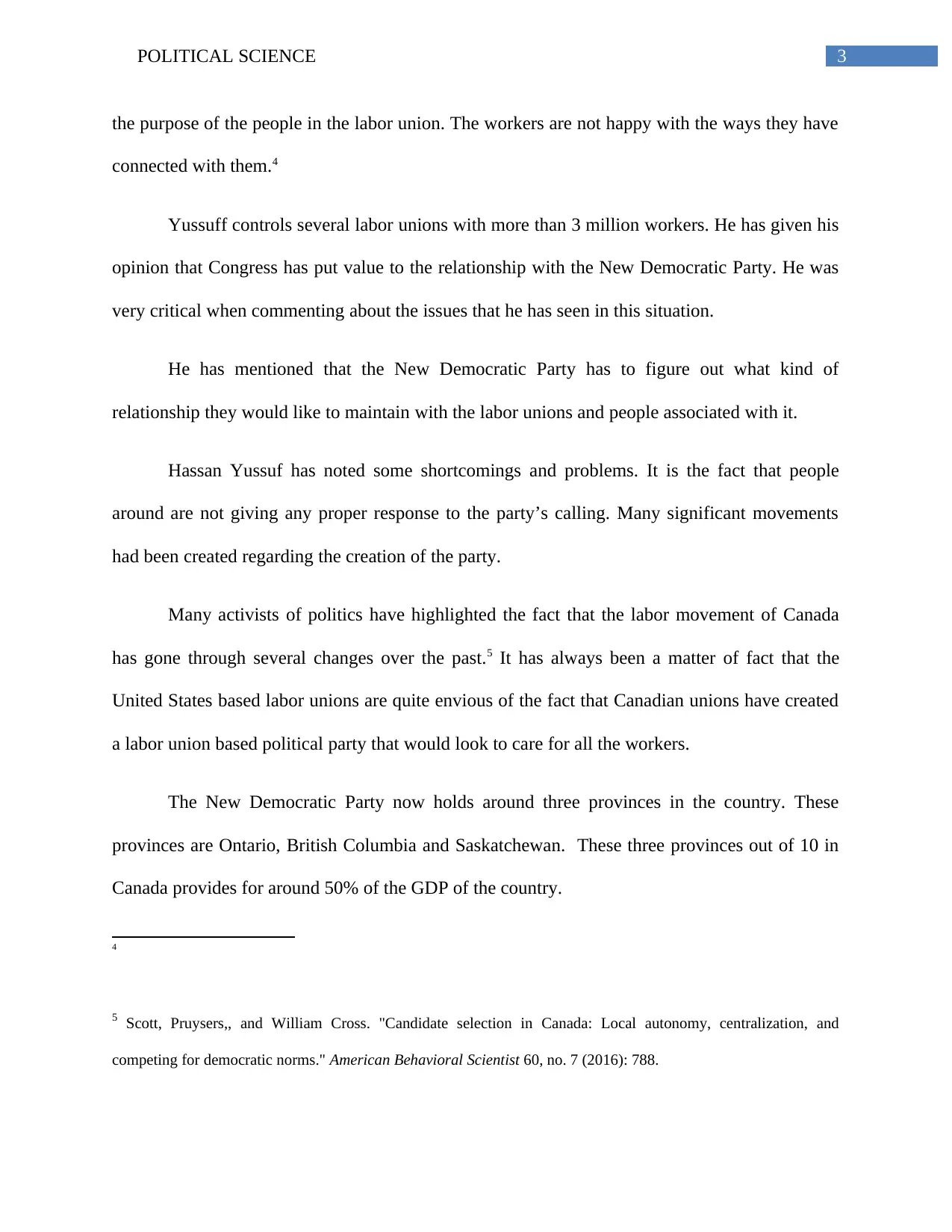
3POLITICAL SCIENCE
the purpose of the people in the labor union. The workers are not happy with the ways they have
connected with them.4
Yussuff controls several labor unions with more than 3 million workers. He has given his
opinion that Congress has put value to the relationship with the New Democratic Party. He was
very critical when commenting about the issues that he has seen in this situation.
He has mentioned that the New Democratic Party has to figure out what kind of
relationship they would like to maintain with the labor unions and people associated with it.
Hassan Yussuf has noted some shortcomings and problems. It is the fact that people
around are not giving any proper response to the party’s calling. Many significant movements
had been created regarding the creation of the party.
Many activists of politics have highlighted the fact that the labor movement of Canada
has gone through several changes over the past.5 It has always been a matter of fact that the
United States based labor unions are quite envious of the fact that Canadian unions have created
a labor union based political party that would look to care for all the workers.
The New Democratic Party now holds around three provinces in the country. These
provinces are Ontario, British Columbia and Saskatchewan. These three provinces out of 10 in
Canada provides for around 50% of the GDP of the country.
4
5 Scott, Pruysers,, and William Cross. "Candidate selection in Canada: Local autonomy, centralization, and
competing for democratic norms." American Behavioral Scientist 60, no. 7 (2016): 788.
the purpose of the people in the labor union. The workers are not happy with the ways they have
connected with them.4
Yussuff controls several labor unions with more than 3 million workers. He has given his
opinion that Congress has put value to the relationship with the New Democratic Party. He was
very critical when commenting about the issues that he has seen in this situation.
He has mentioned that the New Democratic Party has to figure out what kind of
relationship they would like to maintain with the labor unions and people associated with it.
Hassan Yussuf has noted some shortcomings and problems. It is the fact that people
around are not giving any proper response to the party’s calling. Many significant movements
had been created regarding the creation of the party.
Many activists of politics have highlighted the fact that the labor movement of Canada
has gone through several changes over the past.5 It has always been a matter of fact that the
United States based labor unions are quite envious of the fact that Canadian unions have created
a labor union based political party that would look to care for all the workers.
The New Democratic Party now holds around three provinces in the country. These
provinces are Ontario, British Columbia and Saskatchewan. These three provinces out of 10 in
Canada provides for around 50% of the GDP of the country.
4
5 Scott, Pruysers,, and William Cross. "Candidate selection in Canada: Local autonomy, centralization, and
competing for democratic norms." American Behavioral Scientist 60, no. 7 (2016): 788.
Paraphrase This Document
Need a fresh take? Get an instant paraphrase of this document with our AI Paraphraser
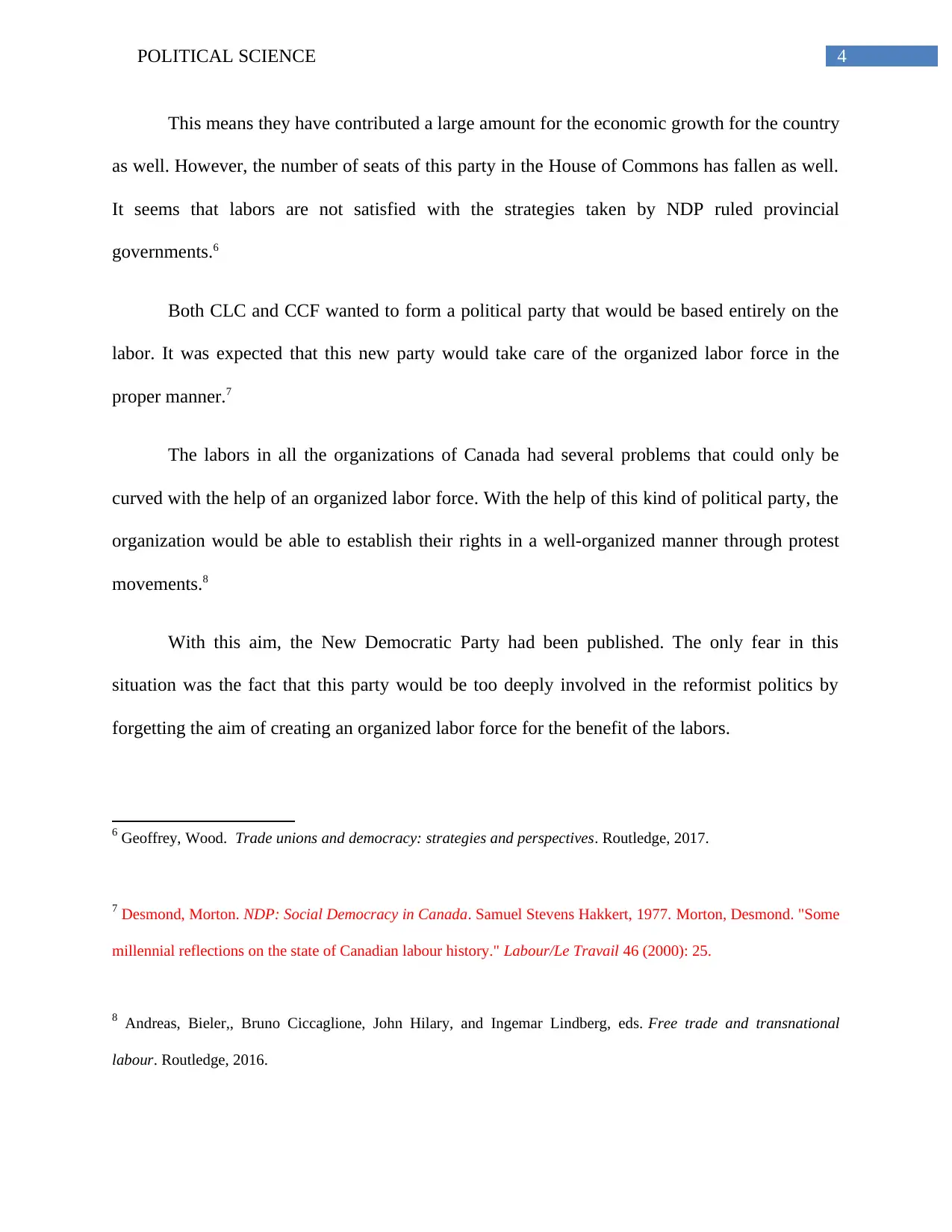
4POLITICAL SCIENCE
This means they have contributed a large amount for the economic growth for the country
as well. However, the number of seats of this party in the House of Commons has fallen as well.
It seems that labors are not satisfied with the strategies taken by NDP ruled provincial
governments.6
Both CLC and CCF wanted to form a political party that would be based entirely on the
labor. It was expected that this new party would take care of the organized labor force in the
proper manner.7
The labors in all the organizations of Canada had several problems that could only be
curved with the help of an organized labor force. With the help of this kind of political party, the
organization would be able to establish their rights in a well-organized manner through protest
movements.8
With this aim, the New Democratic Party had been published. The only fear in this
situation was the fact that this party would be too deeply involved in the reformist politics by
forgetting the aim of creating an organized labor force for the benefit of the labors.
6 Geoffrey, Wood. Trade unions and democracy: strategies and perspectives. Routledge, 2017.
7 Desmond, Morton. NDP: Social Democracy in Canada. Samuel Stevens Hakkert, 1977. Morton, Desmond. "Some
millennial reflections on the state of Canadian labour history." Labour/Le Travail 46 (2000): 25.
8 Andreas, Bieler,, Bruno Ciccaglione, John Hilary, and Ingemar Lindberg, eds. Free trade and transnational
labour. Routledge, 2016.
This means they have contributed a large amount for the economic growth for the country
as well. However, the number of seats of this party in the House of Commons has fallen as well.
It seems that labors are not satisfied with the strategies taken by NDP ruled provincial
governments.6
Both CLC and CCF wanted to form a political party that would be based entirely on the
labor. It was expected that this new party would take care of the organized labor force in the
proper manner.7
The labors in all the organizations of Canada had several problems that could only be
curved with the help of an organized labor force. With the help of this kind of political party, the
organization would be able to establish their rights in a well-organized manner through protest
movements.8
With this aim, the New Democratic Party had been published. The only fear in this
situation was the fact that this party would be too deeply involved in the reformist politics by
forgetting the aim of creating an organized labor force for the benefit of the labors.
6 Geoffrey, Wood. Trade unions and democracy: strategies and perspectives. Routledge, 2017.
7 Desmond, Morton. NDP: Social Democracy in Canada. Samuel Stevens Hakkert, 1977. Morton, Desmond. "Some
millennial reflections on the state of Canadian labour history." Labour/Le Travail 46 (2000): 25.
8 Andreas, Bieler,, Bruno Ciccaglione, John Hilary, and Ingemar Lindberg, eds. Free trade and transnational
labour. Routledge, 2016.
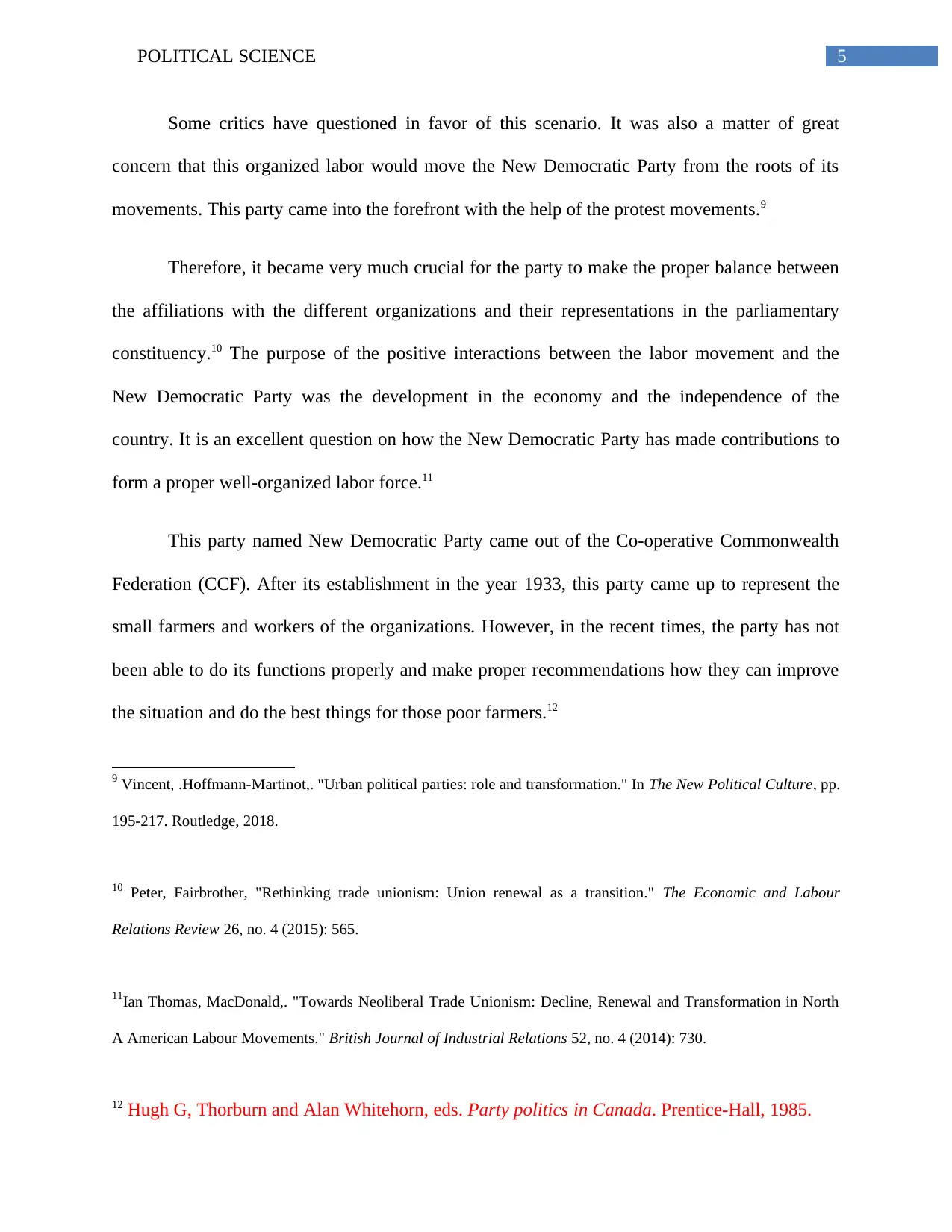
5POLITICAL SCIENCE
Some critics have questioned in favor of this scenario. It was also a matter of great
concern that this organized labor would move the New Democratic Party from the roots of its
movements. This party came into the forefront with the help of the protest movements.9
Therefore, it became very much crucial for the party to make the proper balance between
the affiliations with the different organizations and their representations in the parliamentary
constituency.10 The purpose of the positive interactions between the labor movement and the
New Democratic Party was the development in the economy and the independence of the
country. It is an excellent question on how the New Democratic Party has made contributions to
form a proper well-organized labor force.11
This party named New Democratic Party came out of the Co-operative Commonwealth
Federation (CCF). After its establishment in the year 1933, this party came up to represent the
small farmers and workers of the organizations. However, in the recent times, the party has not
been able to do its functions properly and make proper recommendations how they can improve
the situation and do the best things for those poor farmers.12
9 Vincent, .Hoffmann-Martinot,. "Urban political parties: role and transformation." In The New Political Culture, pp.
195-217. Routledge, 2018.
10 Peter, Fairbrother, "Rethinking trade unionism: Union renewal as a transition." The Economic and Labour
Relations Review 26, no. 4 (2015): 565.
11Ian Thomas, MacDonald,. "Towards Neoliberal Trade Unionism: Decline, Renewal and Transformation in North
A American Labour Movements." British Journal of Industrial Relations 52, no. 4 (2014): 730.
12 Hugh G, Thorburn and Alan Whitehorn, eds. Party politics in Canada. Prentice-Hall, 1985.
Some critics have questioned in favor of this scenario. It was also a matter of great
concern that this organized labor would move the New Democratic Party from the roots of its
movements. This party came into the forefront with the help of the protest movements.9
Therefore, it became very much crucial for the party to make the proper balance between
the affiliations with the different organizations and their representations in the parliamentary
constituency.10 The purpose of the positive interactions between the labor movement and the
New Democratic Party was the development in the economy and the independence of the
country. It is an excellent question on how the New Democratic Party has made contributions to
form a proper well-organized labor force.11
This party named New Democratic Party came out of the Co-operative Commonwealth
Federation (CCF). After its establishment in the year 1933, this party came up to represent the
small farmers and workers of the organizations. However, in the recent times, the party has not
been able to do its functions properly and make proper recommendations how they can improve
the situation and do the best things for those poor farmers.12
9 Vincent, .Hoffmann-Martinot,. "Urban political parties: role and transformation." In The New Political Culture, pp.
195-217. Routledge, 2018.
10 Peter, Fairbrother, "Rethinking trade unionism: Union renewal as a transition." The Economic and Labour
Relations Review 26, no. 4 (2015): 565.
11Ian Thomas, MacDonald,. "Towards Neoliberal Trade Unionism: Decline, Renewal and Transformation in North
A American Labour Movements." British Journal of Industrial Relations 52, no. 4 (2014): 730.
12 Hugh G, Thorburn and Alan Whitehorn, eds. Party politics in Canada. Prentice-Hall, 1985.
⊘ This is a preview!⊘
Do you want full access?
Subscribe today to unlock all pages.

Trusted by 1+ million students worldwide
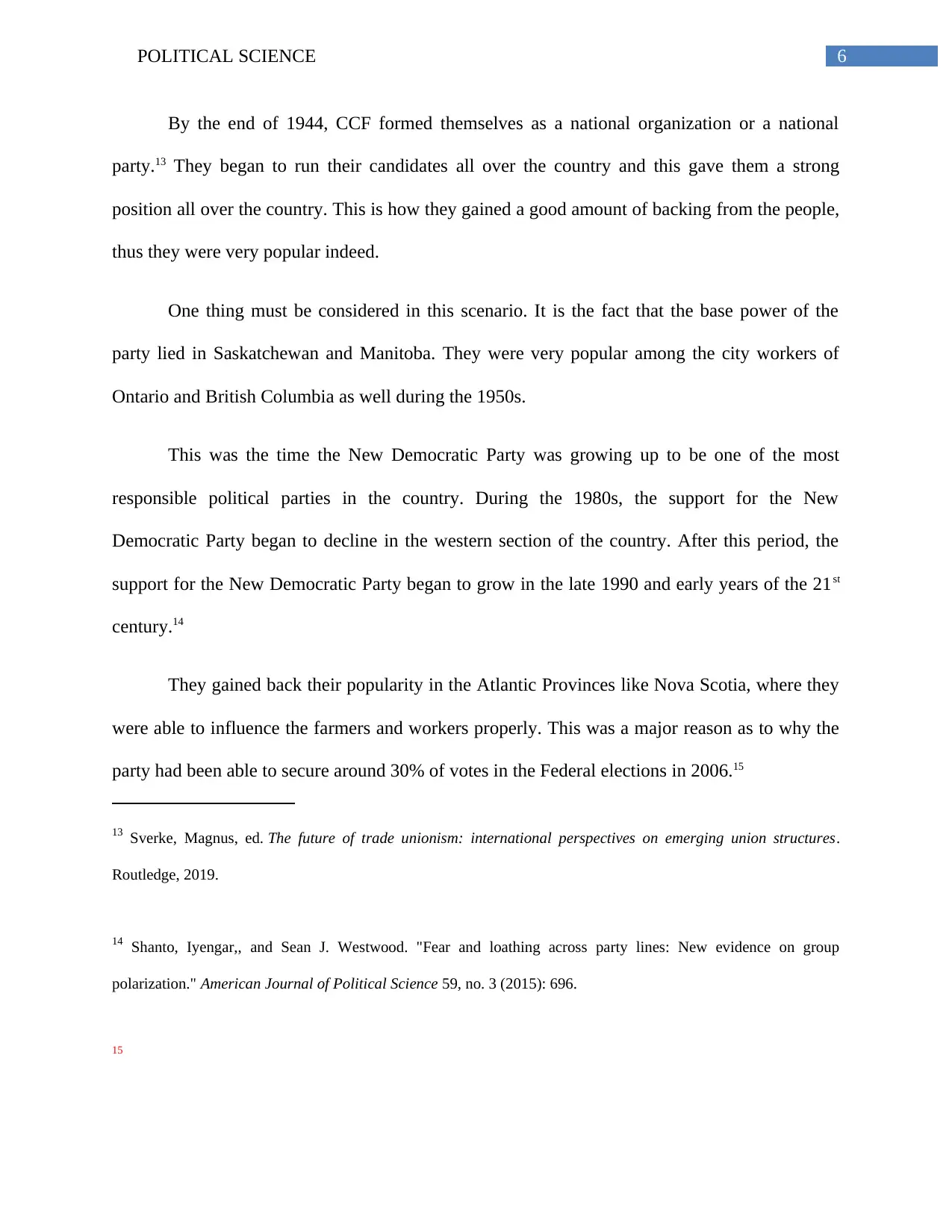
6POLITICAL SCIENCE
By the end of 1944, CCF formed themselves as a national organization or a national
party.13 They began to run their candidates all over the country and this gave them a strong
position all over the country. This is how they gained a good amount of backing from the people,
thus they were very popular indeed.
One thing must be considered in this scenario. It is the fact that the base power of the
party lied in Saskatchewan and Manitoba. They were very popular among the city workers of
Ontario and British Columbia as well during the 1950s.
This was the time the New Democratic Party was growing up to be one of the most
responsible political parties in the country. During the 1980s, the support for the New
Democratic Party began to decline in the western section of the country. After this period, the
support for the New Democratic Party began to grow in the late 1990 and early years of the 21st
century.14
They gained back their popularity in the Atlantic Provinces like Nova Scotia, where they
were able to influence the farmers and workers properly. This was a major reason as to why the
party had been able to secure around 30% of votes in the Federal elections in 2006.15
13 Sverke, Magnus, ed. The future of trade unionism: international perspectives on emerging union structures.
Routledge, 2019.
14 Shanto, Iyengar,, and Sean J. Westwood. "Fear and loathing across party lines: New evidence on group
polarization." American Journal of Political Science 59, no. 3 (2015): 696.
15
By the end of 1944, CCF formed themselves as a national organization or a national
party.13 They began to run their candidates all over the country and this gave them a strong
position all over the country. This is how they gained a good amount of backing from the people,
thus they were very popular indeed.
One thing must be considered in this scenario. It is the fact that the base power of the
party lied in Saskatchewan and Manitoba. They were very popular among the city workers of
Ontario and British Columbia as well during the 1950s.
This was the time the New Democratic Party was growing up to be one of the most
responsible political parties in the country. During the 1980s, the support for the New
Democratic Party began to decline in the western section of the country. After this period, the
support for the New Democratic Party began to grow in the late 1990 and early years of the 21st
century.14
They gained back their popularity in the Atlantic Provinces like Nova Scotia, where they
were able to influence the farmers and workers properly. This was a major reason as to why the
party had been able to secure around 30% of votes in the Federal elections in 2006.15
13 Sverke, Magnus, ed. The future of trade unionism: international perspectives on emerging union structures.
Routledge, 2019.
14 Shanto, Iyengar,, and Sean J. Westwood. "Fear and loathing across party lines: New evidence on group
polarization." American Journal of Political Science 59, no. 3 (2015): 696.
15
Paraphrase This Document
Need a fresh take? Get an instant paraphrase of this document with our AI Paraphraser
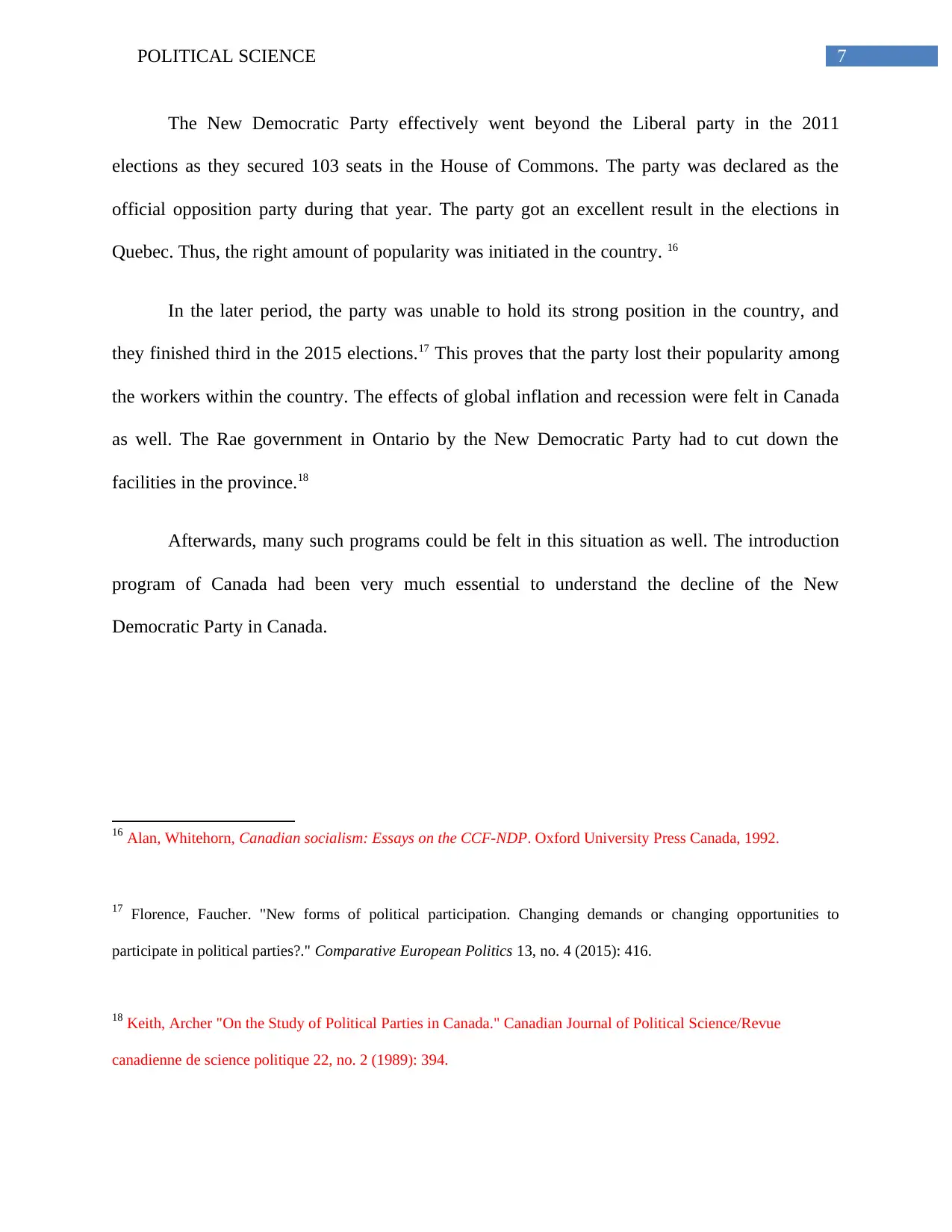
7POLITICAL SCIENCE
The New Democratic Party effectively went beyond the Liberal party in the 2011
elections as they secured 103 seats in the House of Commons. The party was declared as the
official opposition party during that year. The party got an excellent result in the elections in
Quebec. Thus, the right amount of popularity was initiated in the country. 16
In the later period, the party was unable to hold its strong position in the country, and
they finished third in the 2015 elections.17 This proves that the party lost their popularity among
the workers within the country. The effects of global inflation and recession were felt in Canada
as well. The Rae government in Ontario by the New Democratic Party had to cut down the
facilities in the province.18
Afterwards, many such programs could be felt in this situation as well. The introduction
program of Canada had been very much essential to understand the decline of the New
Democratic Party in Canada.
16 Alan, Whitehorn, Canadian socialism: Essays on the CCF-NDP. Oxford University Press Canada, 1992.
17 Florence, Faucher. "New forms of political participation. Changing demands or changing opportunities to
participate in political parties?." Comparative European Politics 13, no. 4 (2015): 416.
18 Keith, Archer "On the Study of Political Parties in Canada." Canadian Journal of Political Science/Revue
canadienne de science politique 22, no. 2 (1989): 394.
The New Democratic Party effectively went beyond the Liberal party in the 2011
elections as they secured 103 seats in the House of Commons. The party was declared as the
official opposition party during that year. The party got an excellent result in the elections in
Quebec. Thus, the right amount of popularity was initiated in the country. 16
In the later period, the party was unable to hold its strong position in the country, and
they finished third in the 2015 elections.17 This proves that the party lost their popularity among
the workers within the country. The effects of global inflation and recession were felt in Canada
as well. The Rae government in Ontario by the New Democratic Party had to cut down the
facilities in the province.18
Afterwards, many such programs could be felt in this situation as well. The introduction
program of Canada had been very much essential to understand the decline of the New
Democratic Party in Canada.
16 Alan, Whitehorn, Canadian socialism: Essays on the CCF-NDP. Oxford University Press Canada, 1992.
17 Florence, Faucher. "New forms of political participation. Changing demands or changing opportunities to
participate in political parties?." Comparative European Politics 13, no. 4 (2015): 416.
18 Keith, Archer "On the Study of Political Parties in Canada." Canadian Journal of Political Science/Revue
canadienne de science politique 22, no. 2 (1989): 394.
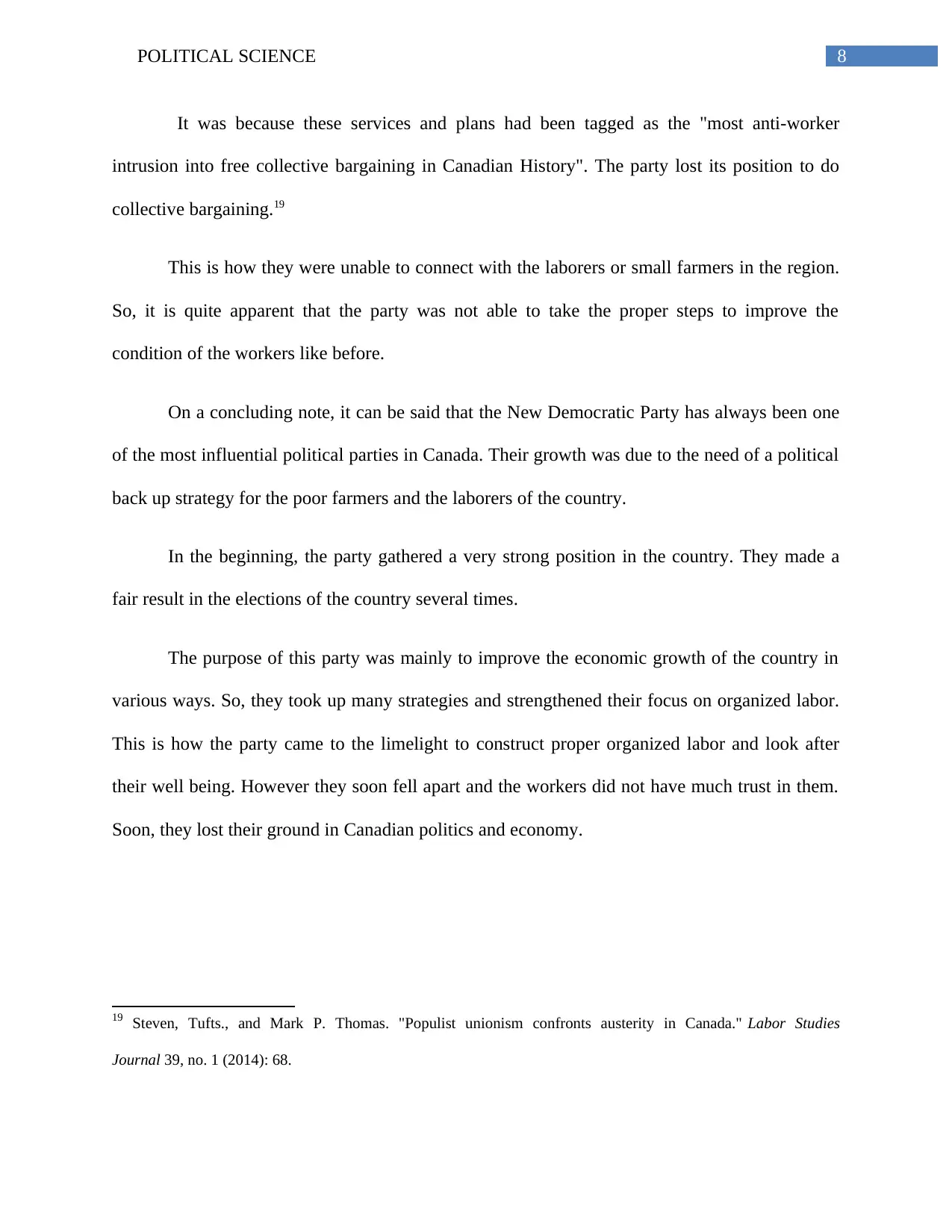
8POLITICAL SCIENCE
It was because these services and plans had been tagged as the "most anti-worker
intrusion into free collective bargaining in Canadian History". The party lost its position to do
collective bargaining.19
This is how they were unable to connect with the laborers or small farmers in the region.
So, it is quite apparent that the party was not able to take the proper steps to improve the
condition of the workers like before.
On a concluding note, it can be said that the New Democratic Party has always been one
of the most influential political parties in Canada. Their growth was due to the need of a political
back up strategy for the poor farmers and the laborers of the country.
In the beginning, the party gathered a very strong position in the country. They made a
fair result in the elections of the country several times.
The purpose of this party was mainly to improve the economic growth of the country in
various ways. So, they took up many strategies and strengthened their focus on organized labor.
This is how the party came to the limelight to construct proper organized labor and look after
their well being. However they soon fell apart and the workers did not have much trust in them.
Soon, they lost their ground in Canadian politics and economy.
19 Steven, Tufts., and Mark P. Thomas. "Populist unionism confronts austerity in Canada." Labor Studies
Journal 39, no. 1 (2014): 68.
It was because these services and plans had been tagged as the "most anti-worker
intrusion into free collective bargaining in Canadian History". The party lost its position to do
collective bargaining.19
This is how they were unable to connect with the laborers or small farmers in the region.
So, it is quite apparent that the party was not able to take the proper steps to improve the
condition of the workers like before.
On a concluding note, it can be said that the New Democratic Party has always been one
of the most influential political parties in Canada. Their growth was due to the need of a political
back up strategy for the poor farmers and the laborers of the country.
In the beginning, the party gathered a very strong position in the country. They made a
fair result in the elections of the country several times.
The purpose of this party was mainly to improve the economic growth of the country in
various ways. So, they took up many strategies and strengthened their focus on organized labor.
This is how the party came to the limelight to construct proper organized labor and look after
their well being. However they soon fell apart and the workers did not have much trust in them.
Soon, they lost their ground in Canadian politics and economy.
19 Steven, Tufts., and Mark P. Thomas. "Populist unionism confronts austerity in Canada." Labor Studies
Journal 39, no. 1 (2014): 68.
⊘ This is a preview!⊘
Do you want full access?
Subscribe today to unlock all pages.

Trusted by 1+ million students worldwide
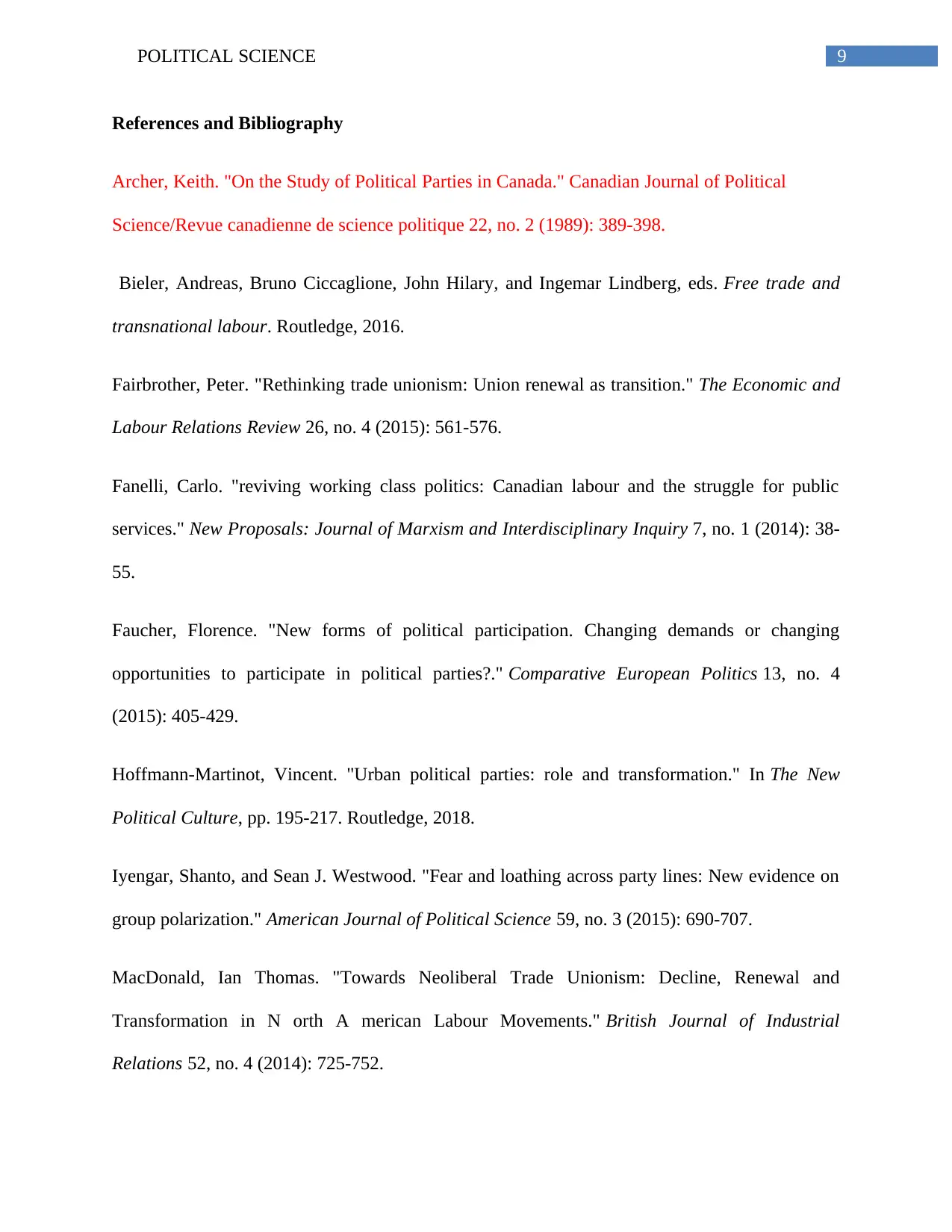
9POLITICAL SCIENCE
References and Bibliography
Archer, Keith. "On the Study of Political Parties in Canada." Canadian Journal of Political
Science/Revue canadienne de science politique 22, no. 2 (1989): 389-398.
Bieler, Andreas, Bruno Ciccaglione, John Hilary, and Ingemar Lindberg, eds. Free trade and
transnational labour. Routledge, 2016.
Fairbrother, Peter. "Rethinking trade unionism: Union renewal as transition." The Economic and
Labour Relations Review 26, no. 4 (2015): 561-576.
Fanelli, Carlo. "reviving working class politics: Canadian labour and the struggle for public
services." New Proposals: Journal of Marxism and Interdisciplinary Inquiry 7, no. 1 (2014): 38-
55.
Faucher, Florence. "New forms of political participation. Changing demands or changing
opportunities to participate in political parties?." Comparative European Politics 13, no. 4
(2015): 405-429.
Hoffmann-Martinot, Vincent. "Urban political parties: role and transformation." In The New
Political Culture, pp. 195-217. Routledge, 2018.
Iyengar, Shanto, and Sean J. Westwood. "Fear and loathing across party lines: New evidence on
group polarization." American Journal of Political Science 59, no. 3 (2015): 690-707.
MacDonald, Ian Thomas. "Towards Neoliberal Trade Unionism: Decline, Renewal and
Transformation in N orth A merican Labour Movements." British Journal of Industrial
Relations 52, no. 4 (2014): 725-752.
References and Bibliography
Archer, Keith. "On the Study of Political Parties in Canada." Canadian Journal of Political
Science/Revue canadienne de science politique 22, no. 2 (1989): 389-398.
Bieler, Andreas, Bruno Ciccaglione, John Hilary, and Ingemar Lindberg, eds. Free trade and
transnational labour. Routledge, 2016.
Fairbrother, Peter. "Rethinking trade unionism: Union renewal as transition." The Economic and
Labour Relations Review 26, no. 4 (2015): 561-576.
Fanelli, Carlo. "reviving working class politics: Canadian labour and the struggle for public
services." New Proposals: Journal of Marxism and Interdisciplinary Inquiry 7, no. 1 (2014): 38-
55.
Faucher, Florence. "New forms of political participation. Changing demands or changing
opportunities to participate in political parties?." Comparative European Politics 13, no. 4
(2015): 405-429.
Hoffmann-Martinot, Vincent. "Urban political parties: role and transformation." In The New
Political Culture, pp. 195-217. Routledge, 2018.
Iyengar, Shanto, and Sean J. Westwood. "Fear and loathing across party lines: New evidence on
group polarization." American Journal of Political Science 59, no. 3 (2015): 690-707.
MacDonald, Ian Thomas. "Towards Neoliberal Trade Unionism: Decline, Renewal and
Transformation in N orth A merican Labour Movements." British Journal of Industrial
Relations 52, no. 4 (2014): 725-752.
Paraphrase This Document
Need a fresh take? Get an instant paraphrase of this document with our AI Paraphraser
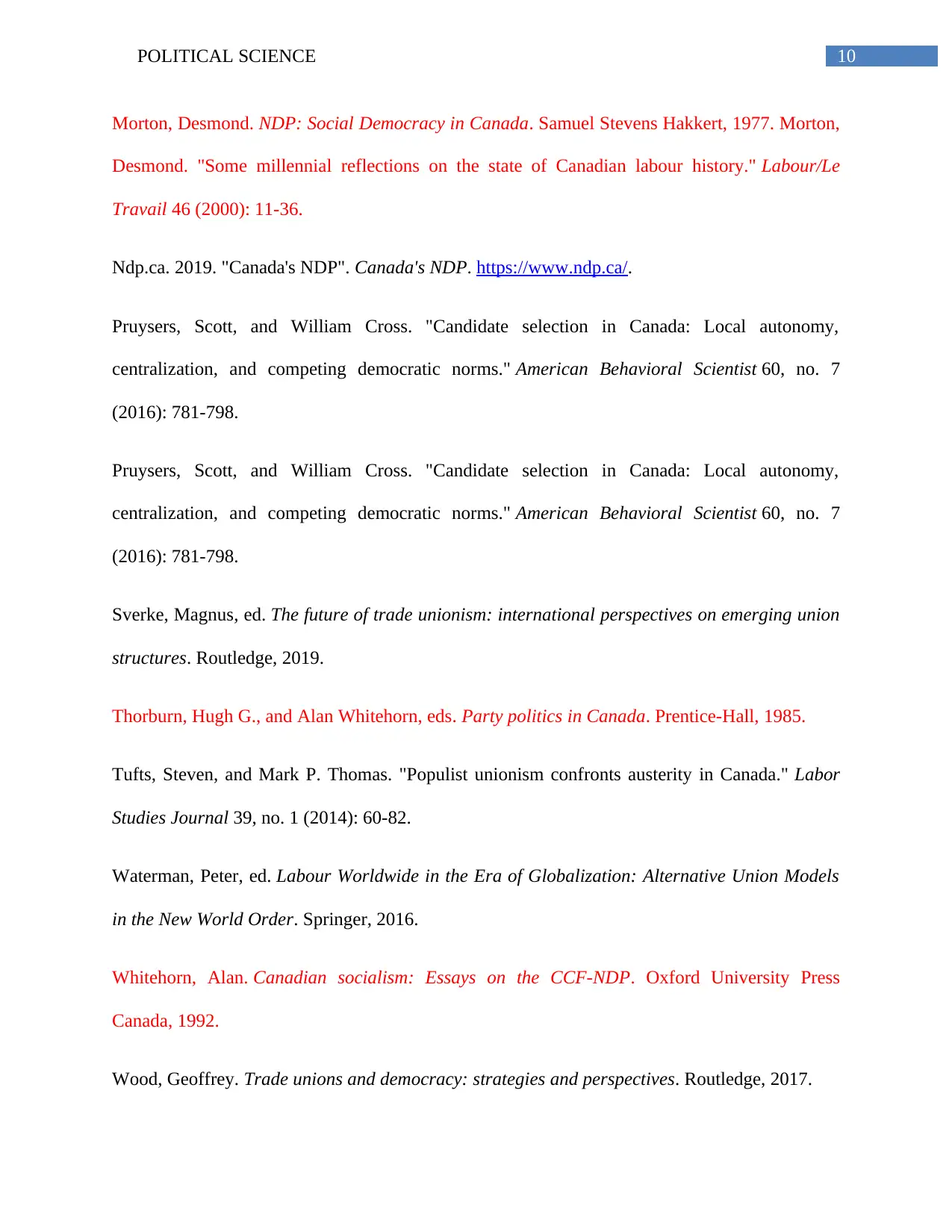
10POLITICAL SCIENCE
Morton, Desmond. NDP: Social Democracy in Canada. Samuel Stevens Hakkert, 1977. Morton,
Desmond. "Some millennial reflections on the state of Canadian labour history." Labour/Le
Travail 46 (2000): 11-36.
Ndp.ca. 2019. "Canada's NDP". Canada's NDP. https://www.ndp.ca/.
Pruysers, Scott, and William Cross. "Candidate selection in Canada: Local autonomy,
centralization, and competing democratic norms." American Behavioral Scientist 60, no. 7
(2016): 781-798.
Pruysers, Scott, and William Cross. "Candidate selection in Canada: Local autonomy,
centralization, and competing democratic norms." American Behavioral Scientist 60, no. 7
(2016): 781-798.
Sverke, Magnus, ed. The future of trade unionism: international perspectives on emerging union
structures. Routledge, 2019.
Thorburn, Hugh G., and Alan Whitehorn, eds. Party politics in Canada. Prentice-Hall, 1985.
Tufts, Steven, and Mark P. Thomas. "Populist unionism confronts austerity in Canada." Labor
Studies Journal 39, no. 1 (2014): 60-82.
Waterman, Peter, ed. Labour Worldwide in the Era of Globalization: Alternative Union Models
in the New World Order. Springer, 2016.
Whitehorn, Alan. Canadian socialism: Essays on the CCF-NDP. Oxford University Press
Canada, 1992.
Wood, Geoffrey. Trade unions and democracy: strategies and perspectives. Routledge, 2017.
Morton, Desmond. NDP: Social Democracy in Canada. Samuel Stevens Hakkert, 1977. Morton,
Desmond. "Some millennial reflections on the state of Canadian labour history." Labour/Le
Travail 46 (2000): 11-36.
Ndp.ca. 2019. "Canada's NDP". Canada's NDP. https://www.ndp.ca/.
Pruysers, Scott, and William Cross. "Candidate selection in Canada: Local autonomy,
centralization, and competing democratic norms." American Behavioral Scientist 60, no. 7
(2016): 781-798.
Pruysers, Scott, and William Cross. "Candidate selection in Canada: Local autonomy,
centralization, and competing democratic norms." American Behavioral Scientist 60, no. 7
(2016): 781-798.
Sverke, Magnus, ed. The future of trade unionism: international perspectives on emerging union
structures. Routledge, 2019.
Thorburn, Hugh G., and Alan Whitehorn, eds. Party politics in Canada. Prentice-Hall, 1985.
Tufts, Steven, and Mark P. Thomas. "Populist unionism confronts austerity in Canada." Labor
Studies Journal 39, no. 1 (2014): 60-82.
Waterman, Peter, ed. Labour Worldwide in the Era of Globalization: Alternative Union Models
in the New World Order. Springer, 2016.
Whitehorn, Alan. Canadian socialism: Essays on the CCF-NDP. Oxford University Press
Canada, 1992.
Wood, Geoffrey. Trade unions and democracy: strategies and perspectives. Routledge, 2017.
1 out of 11
Related Documents
Your All-in-One AI-Powered Toolkit for Academic Success.
+13062052269
info@desklib.com
Available 24*7 on WhatsApp / Email
![[object Object]](/_next/static/media/star-bottom.7253800d.svg)
Unlock your academic potential
Copyright © 2020–2025 A2Z Services. All Rights Reserved. Developed and managed by ZUCOL.





